Báo cáo khoa học: "Investigation of some social factors on the evolution of Avian Influenza (AI) and Foot and mouth disease (FMD) in Luong Son district, Hoa Binh province, Vietnam" ppsx
Bạn đang xem bản rút gọn của tài liệu. Xem và tải ngay bản đầy đủ của tài liệu tại đây (161.61 KB, 7 trang )
Journal of Science and Development April 2008: 112-118 HANOI UNIVERSITY OF AGRICULTURE
Investigation of some social factors on the evolution of Avian Influenza
(AI) and Foot and mouth disease (FMD) in Luong Son district, Hoa Binh
province, Vietnam
Truong Ha Thai*, Huynh T. My Le*, Truong Quang*, Le Van Lanh*, Chu T. Thanh Huong*
*Faculty of Veterinary Medicine (FVM), Hanoi University of Agriculture
Abstract
Understanding the epidemiology and patterns of occurrence of disease is crucial in the
progress toward control (and eventual eradication) of diseases. Each disease is the result of
many natural, social, and geographical linkage factors, such as: the traditional methods in
husbandry, animal transportation, the awareness and attitude of livestock holders, veterinary
extension network, etc. This paper discusses some of the basic agents, focusing on social
factors on the evolution of Avian Influenza (AI) as well as Foot and mouth disease (FMD) in
Luong Son, Hoa Binh province. The study surveyed investigation, surveillance of disease
occurrence, and social factors affecting the movement of diseases. The results will help to
identify causes and sources of the outbreaks with a view to control and prevent disease in the
future. By understanding the basic epidemiology of diseases, disease control programs could be
designed by the authorities.
Key words: Social factors, Avian Influenza (AI), foot and mouth disease (FMD), Luong Son,
Hoa Binh.
1. INTRODUCTION
Avian Influenza (AI) and Foot and Mouth
Disease (FMD) have been spreading all over
the World for some years ago. They caused
enormous losses for households as well as
livestock production from industrial to small
scales. In 2003, AI occurred in 57 out of 64
provinces in Vietnam. There were over 44
billion head of poultry (17% of total number)
infected, dead or damaged. Estimated loss was
nearly 120 million USD, equal to 0.3% of the
GDP (According to the report of the
Department of Animal Health of Vietnam -
DAH, 2007). In the year 2006, FMD spread in
40 provinces. According to the DAH, there
were about 30.000 infected, and dead cattle and
pigs. In the past few years, AI and FMD have
brought many difficulties in livestock
production and in social-economic development
of the Hoa Binh province and the Luong Son
district. According to the concepts of
epidemiology, disease is a result of many
linkage factors. Each disease is not only
influenced by many natural and social rules and
their properties, but also the awareness and
knowledge of farmers play an important role in
the development of diseases. Because of the
reasons mentioned above, we carried out a
study: “Investigation of some social factors on
the evolution of Avian Influenza (AI) and Foot
and Mouth Disease (FMD) in Luong Son
district, Hoa Binh province”.
2. MATERIALS AND METHODS
2.1. Materials
Questionnaire and data collected from the
veterinary office of the Luong Son district.
112
Journal of Science and Development April 2008: 112-118 HANOI UNIVERSITY OF AGRICULTURE
2.2. Methods
- Interviewing households and filling the
questionnaire with the help from local veterinarians
- Retrieving data
- Analyzing data according to
epidemiologic methods
3. RESULTS AND DISCUSSION
Luong Son is upland area with a low
annual average income per person of
approximately 4.5 to 5.0 million VND/ person/
year (Annual report of the Veterinary
Department in Luong Son, Hoa Binh, 2006).
Although the contribution of livestock to the
GDP of the Luong Son district is not high, it is
the main food supply for people here.
In Luong Son, AI appeared in the years of
2003 and 2004 at 2/3 of the surveyed
communes including Hoa Son, Cu Yen, and
excepting Nhuan Trach commune. According to
the statistic of the Veterinary Department in
Luong Son, in 2003, there were 14 infected
areas, and 2300 infected poultry were
destroyed. In 2004, Hoa Son was the only
commune which had AI, and 1500 head were
destroyed. From 2005 to the end of our study,
there was no report of AI from local areas.
With regard to FMD, the disease did not
appear in years 2003, 2004 and 2007 at the 3
referred communes. However, in 2005 and
2006, FMD occurred at all 3 communes,
causing big losses (Annual report of the
Veterinary Department in Luong Son, Hoa
Binh). In 2005, there were 18 infected areas
and 30 destroyed animals. It was said that the
number of sick animals killed did not
eliminate FMD. In our opinion, that was a risk
for an FMD outbreak in year 2006.In year
2006 FMD spread in our whole country. At 3
investigated communes, there was an increase
in number of both infected areas and destroyed
animals as follows: 28 infected areas and 56
killed animals in total.
3.1. The habit of livestock holders in choice
of sources of breeding supply
Table 1. Sources of breed supplier.
Breed supplier
Self supporting Local market Breeding center
Commune
No. of
farmers
No. Rate (%) No. Rate (%) No. Rate (%)
Nhuan Trach 390
144 36.92 217 55.64 31 7.95
Hoa Son 345
119 34.49 199 57.68 25 7.25
Cu Yen 265
97 36.60 149 56.23 19 7.17
Sum 1000
360 36.00 565 56.50 75 7.50
Breed quality is one factor that takes into
account the success of raising animals. Good
breeds can yield high quantity product, resist
diseases, and require less food intake (Toma et
al., 1996).
Our results indicated that the main
sources of breed supply were self-supplier
with the rate of 56.50% and the local market
(36.00%). A few investigated households
(7.50%) bought breeds of animals from the
breeding center. There was no certificate for
breed from private/ unofficial sources, the
animal’s productivity was not high and they
might be infected and catch diseases easily.
Apart from breed, quality of feed used can
cause decline in productivity or increase in
morbidity/ mortality rate during the raising
period.
3.2. The animal production mode at local
areas
Mode and techniques applied in animal
production are important factors. Diseases are
reduced significantly and more income is
113
Investigation of some social factors on the evolution of Avian Influenza (AI)
created if suitable technical measures are
presented in each household (Toma et al. 1996).
In the pig production sector we found that
100% of investigated farmers kept their pigs in
pigpens which were simply built. Raising
conditions were poor: high humidity; lack of
sanitation; accumulation of urine, feces, etc.
This affected the growing rate and spread of
disease.
In the cattle production sector the percentage
of farms with shelter for animals was 15.18%
(104 cases in 685 cases total). Most of them were
in a dairy production development program.
There were about 76.79% and 8.03% of farms
using the semi- natural pastures method and the
traditional method, respectively. Because the
herd was not managed (holders let them range
free), Foot and Mouth Disease (FMD) broke
out and spread through way of direct contact to
healthy cattle.
In the poultry sector nearly 10.49% were
small-scale to semi-intensive productions. In
contrast, 89.57% of holders used traditional
modes (raising poultry outdoors on pasture).
The high rate of un-managed flocks was also a
reason for spreading of disease from area to
area.
3.3. Purpose of livestock holders in production
and selling
The results of our survey in Table 2
indicated that most of the farm holders
(89.10%) raised animals for their daily needs:
meat, eggs and milk. We also found that only
7.50% of producers find another output for their
livestock product (under the support of some
ongoing programs or a few animal feed
companies). Meanwhile, 92.5% of farm holders
sold their product directly to customers at local
markets but in a small scale. The logical result
of the above situations lead to careless of
selection breeds, hygiene, and disease
prevention. In general, the farmer’s concerns on
livestock development depend on the purpose
of raising and income benefit (Cameron et al,
1999). They will rear animals carefully, and
follow disease prevention strategies when the
output for their products is managed.
However, with the properties of the local’s
livestock production system (such as, farm
animals raised in small scale, using agro-
byproducts, lack of market orientation etc.),
people did not pay enough attention to either
their animals or their diseases.
Table 2. Purpose of production and selling.
Purpose of production Ways of selling
Breeding Meat, egg, milk Local market
Collected by
company
Commune
No. of
investigated
farmers
No. Rate(%) No. Rate (%) No. Rate(%) No. Rate(%)
Nhuan Trach
390 41 10.5 349 89.5 372 95.4 18 4.6
Hoa Son
345 37 10.7 308 89.3 312 90.4 33 9.6
Cu Yen
265 31 11.7 234 88.3 241 90.9 24 9.1
Sum
1000 109 10.90 891 89.10 925 92.50 75 7.50
Therefore, when infectious diseases occurred,
they threw carcasses away, slaughtered, or even
sold ill animals illegally. People also neglected
reporting to technical agencies. All the above
difficulties increase the likelihood of disease
spread and silent circulation.
3.4. Attitudes of local people toward
vaccination
114
Truong Ha Thai, Huynh T. My Le, Truong Quang, Le Van Lanh, Chu T. Thanh Huong
Vaccination is an effective way to
prevent and control diseases (Morris and
Jackson, 2005). In fact, diseases cannot or
rarely occur in the areas where a vaccination
strategy is strictly applied. A low level of
vaccine use plus weakness of local authorities
creates ideal chances for the outbreak of
diseases. Base on the analyzed data in Table
3, local people were concerned about
vaccination when diseases broke out or
vaccine was freely administered.
Our results revealed the fact that
mandatory vaccines (FMD and AI vaccine)
were not completely used at all investigated
communes. It might rotation of result from herd
without the additional vaccination, neglectful
behavior among people, inadequacy of local
authorities, insufficient veterinarians and
shortage of budget for vaccination programs. In
such a situation, the risk of FMD and AI was
high and unknown dueto the presence of
susceptible animals in the population,
especially when the two outbreaks were not
completely under control.
Table 3. Concern of local people on vaccination strategies at investigated communes
Cattle vaccination Poultry vaccination
FMD vaccine Others AI vaccine Others
Commune
No. of
farmers
No. Rate (%) No. Rate (%)
No. of
farmers
No. Rate (%) No.
Rate
(%)
NT 325 287 88.31 173 53.23 344 318 92.44 61 17.73
HS 298 255 85.57 167 56.04 299 273 91.30 54 18.06
CY 232 196 84.48 131 56.47 216 192 88.89 42 19.44
Sum 855 738 86.32 471 55.09 859 783 91.15 157 18.28
3.5. Attitudes of local people toward hygiene
Hygiene applied in livestock production is
considered one of the most important factors. It
reduces mortality and promotes productivity.
As a general rule, animal health and hygiene are
directly linked (Dao Ngoc Phong, 2001).
Therefore, when farm animals are kept in clean,
well-ventilated breeding facilities, they will
grow faster and have fewer diseases. Otherwise,
they might require more food intake and easily
fall into bad condition.
The condition of breeding facilities in the
three communes was generally low and did not
follow the hygiene standard. They were dirty
with high humidity. People did not collect waste
(urine, feces, etc.), which accumulated directly to
gardens or drain systems before any treatment
process. The study showed that only 29.30% of
households were cleaned up daily. In contrast,
70.70% of the others were rarely or never
cleaned. Up to 87.0% of farm holders did not
process waste. The households (13.0%) that
performed waste processing used a Biogas
system or some bio-based method. The rate of
households that used chemicals to disinfect was
extremely low (8.10%). All of those facts created
a bad environment for animals and brought ideal
conditions for the survival of many germs. That
was why the mortality of local farm animals due
to a wide range of diseases including FMD and
AI was high.
We found that many local farmers have no
quarantine areas for new introduced animals
(94.20%). This caused a high potential for
diseases occurring, as new animals might suffer
from illness or carry germs having no clinical
symptoms.
3.6. Behaviors of local people to the outbreak
of diseases
115
Investigation of some social factors on the evolution of Avian Influenza (AI)
Besides veterinary authorities on enforcing
disease control and prevention measures, once
diseases broke out farmers’ behaviors
significantly contributed to the success of
prevention, quarantine, controlling and
overcoming damage progress. Farmers and
holders following orders in destroying infected
animals, reporting suspected sick animals as
soon as possible to the veterinarians, using
appropriate disinfectant to keep the raising
environment clean, etc. will help to control
outbreak, and prevent serious damage to the
national economy or threat to human health
(Martin et al., 1987).
From the data in Table 4, we realized that
farmers who had been investigated did not have
good behavior towards disease prevention.
There were 84.30% of interviewes
responding “yes” to the question “will you
follow up the command to destroy your
infected poultry or cattle”? In fact, a large
number of households (79.20%) sold their
infected animals illegally at the first sign of
outbreak, 16.0% of farm holders threw ill
animals away. Farmers who destroyed animals
following procedure were lowest with the rate
equal to 4.8%. There were 13.80% of farmers
that reported diseases to local veterinarians,
meanwhile most of them (86.20%) took no
action. These facts require urgent attention of
authorities, due to the high risk of
reoccurrence of diseases. Apart from those
facts, awareness of keeping their breeding
facilities clean was poor: 64.30% households
did not perform disinfection; only 35.70%
were applying sanitary methods to eliminate
disease agents.
Table 4. Awareness of local people dealing with diseases in the production sector.
Treatment of ill
animals
Reporting
diseases
Carcass processing Disinfection
Follow the
destraction order
Commune
No. of holders
Local
vet
Self medicating
Yes
No
Sell, slaughter
illegally
Throw away
Destroy
Yes
No
Yes
No
272 118 58 332 314 64 12 135 255 341 49
NT 390
69.74% 30.26% 14.87% 85.13% 80.51% 16.41% 3.08% 34.62% 65.38% 87.44% 12.56%
238 107 45 300 271 57 17 124 221 284 61
HS 345
68.99% 31.01% 13.04% 86.96% 78.55% 16.52% 4.93% 35.94% 64.06% 82.32% 17.68%
191 74 35 230 207 39 19 98 167 218 47
CY 265
72.08% 27.92% 13.21% 86.79% 78.11% 14.72% 7.17% 36.98% 63.02% 82.26% 17.74%
701 299 138 862 792 160 48 357 643 843 157
Sum 1000
70.10% 29.90% 13.80% 86.20% 79.20% 16.00% 4.80% 35.70% 64.30% 84.30% 15.70%
In addition, up to 29.90% of farmers cured
sick animals themselves, and did not have a clear
understanding about diseases and mechanisms of
drug actions. The above behaviors of local
people raised the risk of drug resistance or put
animals into a chronic stage, carrying germs
consistently.
3.7. Recovery of livestock production after
outbreaks
Any harmful microorganisms have a
potential of surviving outside their host for a
limited time (Nguyen Nhu Thanh, 2001).
Therefore, it is essential to keep raising areas
empty for sufficient periods to destroy most
116
Truong Ha Thai, Huynh T. My Le, Truong Quang, Le Van Lanh, Chu T. Thanh Huong
of the germs before resumption of raising
(Toma et al., 1996). This simple procedure is
very useful in disease prevention. However,
like other farmers in our country, farmers at
Hoa Binh province continued to raise animals
after diseases had settled down without
permission of the local officer. This has
brought about uncontrollable FMD and AI in
Vietnam.
Our results revealed the situation after
outbreak as follows: 66.0% of households started
to resume livestock raising right after the
outbreak stopped; 26.40% waited for a long
enough time. A high rate of households
(87.50%) answered that they would not start to
raise another breed. Answering the question,
“what is your concern on livestock
production”? above 80% of households paid
attention to techniques of production, 55.60%
to the outputs of product, 54.90% to capital,
40.50% were interested in breeding, and 24.40%
to the feed used.
Those data reflected an overall picture in
livestock production of local farmers: small
scale, scattered, and lack of capital and output
for the product. The limitation of knowledge in
taking care of farm animals, paying inadequate
attention to livestock production etc., set a high
risk of reoccurrence.
3.8. Involvement of local authorities disease
control and prevention
Local authorities and veterinarians are
human resources that directly participate in
disease control and prevention. Therefore,
the effective activities of local authorities
will be a barrier against the threat of
diseases (Toma et al., 1996). One positive
result is that 100% of local farmers receive
AI and FMD update information from a
variety of communications.
Table 5. Role and responsibility of local authorities and veterinary services to disease prevention
and control.
Source of AI and FMD
information
Veterinarian response Vaccinator
Commune
No. of farmers
Local
committee
Other
sources
Immediate
Delayed
No response
Vet.
Services
Self -performad
314 390 134 221 35 355 151 57
Nhuan Trach 390
80.51% 100% 34.4% 56.7% 8.97% 91.0% 38.7% 14.6%
298 343 112 187 46 317 142 52
Hoa Son 345
86.38% 100% 32.5% 54.2% 13.3% 91.9% 41.2% 15.1%
211 265 86 145 34 241 110 38
Cu yen 265
79.62% 100% 32.5% 54.7% 12.8% 90.8% 41.5% 14.3%
823 1000 332 553 115 913 403 147
Sum 1000
82.30% 100% 33.20% 55.3% 11.50% 91.3% 40.3% 14.7%
To act effectively requires a big effort of
local committees and veterinarians because of
the large areas, difficulties in transportation and
scattered households. There was a complaint
from farmers about the response of veterinarians’
services. Up to 55.30% of households reported
veterinarians coming late after receiving diseases
information, 11.50% had no response and
117
Investigation of some social factors on the evolution of Avian Influenza (AI)
33.20% had a home visit immediately. In fact, it
was difficult to fulfill all the needs of farm
holders with the veterinary extension network in
Luong Son, Hoa Binh. But with the efforts of
local veterinarians, the rate of undertaking
vaccination was quite high (91.30%).
Only 14.70% of the households vaccinated
by themselves because of unavailable local
veterinary services. We hope the local
authorities, including veterinary services, will do
their best to prevent the spread dangerous of AI
and FMD.
4. CONCLUSIONS
In Luong Son, Hoa Binh province, the
knowledge of livestock holders about disease
was still limited. All of them contributed to the
difficulties of disease prevention and control.
Farmers had never quarantined new animals
before introduction to the herd. Households
lacked concern on disease control and
prevention and did not follow vaccination
orders completely. Normally, they did not
report diseases to local authorities, or even to
farm veterinarians. Usually they sold sick
animals illegally, etc.
The veterinary extension networks did not
have enough human resources to contribute to
the disease prevention programme. Difficulties
arose from topography, farmers’ habit etc The
local veterinary system and veterinarians need to
be strengthened. Local authorities should have
strategies to change livestock production from
small-scales to semi industrial/industrial scales,
and avoid raising certain kinds of breeds to
eliminate risk of cross-transmission. Local
committees need to promote attitudes about
disease prevention, including vaccination,
destroying sick animals, hygiene, setting up
waste processing by a short training course,
making a fresh and disease-free environment for
sustained development.
ACKNOWLEDGEMENT
The present studies were conducted by the
special fund of the Rockefeller Foundation at
Hanoi University of Agriculture. Recent data
about the AI and FMD situation has been
obtained from the reports of the annual statistics
of the Veterinary Department at Luong Son, Hoa
Binh province. The livestock holders as well as
local staff at 3 communes (Nhuan Trach, Cu
Yen, Hoa Son) in Luong Son, Hoa Binh offered
us great cooperation in our field investigation.
We would like to express our deep gratitude to
them for their kindness and help.
REFERENCES
Cameron A.R. et al. (1999). "Epidemiology and
Dynamics of major livestock disease in
Souththeast Asia", ACIAR, 1999.
Toma. B. et al. (1996). "Applied veterinary
epidemiology and the control of disease
in population", Translated from the
French edition.
Đào Ngọc Phong (2001). “Vệ sinh môi trường -
Dịch tễ” vol I, II, III, Medicine
Publication, 2001.
Martin, S.W., Meek, A.H and Willerberg, P.
(1987). "Veterinary epidemiology -
principles and methods". Ames, Iowa,
Iowa State Unit Press, page 283 - 291.
Nguyễn Như Thanh (2001). “Cơ sở của phương
pháp nghiên cứu dịch tễ họ
c thú y”,
Agriculture Publication, 2001.
Anual Report of the Veterinary Department at
Luong Son, Hoa Binh, 2006.
Report of the Department of Animal Health of
Vietnam,
/>tion=com_content&task=view&id=536&
Itemid=67
R.S. Morris and R. Jackson (2005). "
Epidemiology of H5N1 Avian Influenza
in Asia and Implication for regional
control", Epicentre, Massey University
Palmerston North, New Zealand.
118
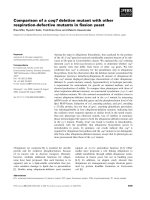
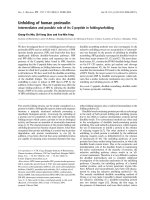
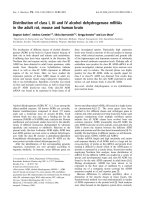
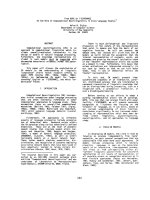
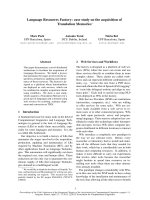
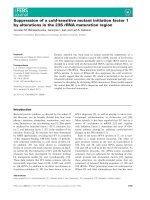
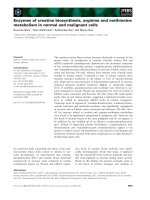
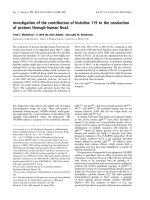
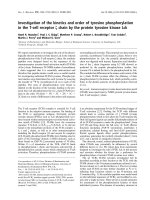
![Báo cáo khoa học: Epoxidation of benzo[a]pyrene-7,8-dihydrodiol by human CYP1A1 in reconstituted membranes Effects of charge and nonbilayer phase propensity of the membrane pot](https://media.store123doc.com/images/document/14/rc/ld/medium_ldo1394248806.jpg)